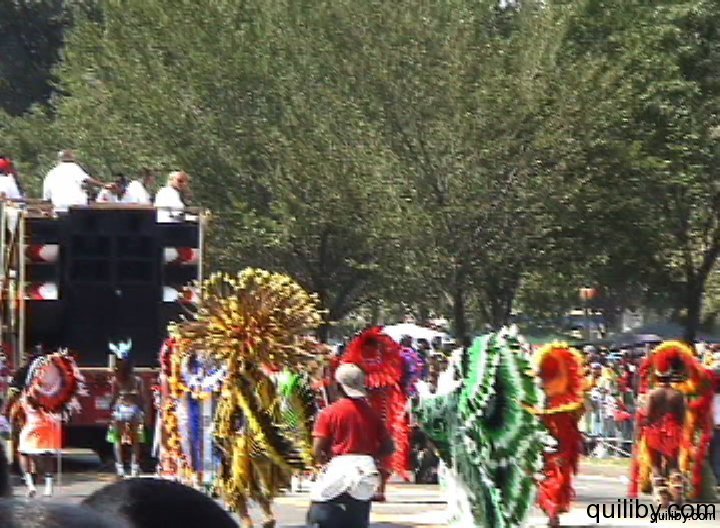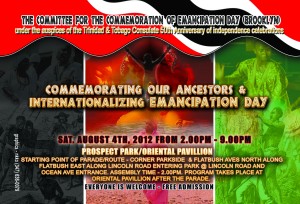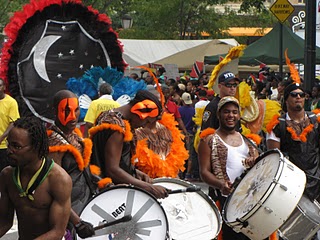
Mas’ in New York
Every Labor Day, since the mid-sixties, Brooklyn New York has played host to the masquerade, pulsating rhythmic sounds, and free-spirited abandon that exudes from the West Indian Carnival. From a solitary procession, the event has grown to festivities that occupy the entire weekend that leads into the first monday in September. In addition to the Parade of Bands on the Eastern Parkway, the early morning Jouvay has long become a staple of the Labor Day bacchanal. Additionally, on the preceding Saturday, the young aspiring masqueraders hold court when the bands in the Children’s Carnival wind their way to the Brooklyn Museum, where – later in the evening – the clash of steel in the annual Panorama Competition can be heard ringing through the Brooklyn landscape. For the hundreds of thousands of Caribbean migrants, who have made New York their home over the last century, this annual celebration bears significance of immense proportions.
Brief History
The Carnival celebrations held in Brooklyn today are not the first of this type in New York. The Caribbean-style masquerade was initiated by the migrants from the Caribbean isles, who came to the New York metropolis in the first half of the the last century. Jesse Waddell, a Caribbean woman from Trinidad, is recognized as the individual responsible for the introduction of this type of celebrations. A musician, who came to the New York in the early 1920s, she hosted masquerade balls during the 1930s and early ’40s in venues such as the Renaissance Ballroom in Harlem. Following World War II, Waddell, in conjunction with the West Indian Day Committee, gained permission from the City to host an outdoor Carnival parade in Harlem. This festival was successfully produced annually until 1964, when the permit was revoked.
This period witnessed the rise in popularity of calypso, the music of the West Indian Carnival, in New York and the American popular music industry. Guitarist Gerard Clarke and his Caribbean Serenders played on many calypso recordings and in venues such as the Vanguard. Pianist and bandleader Lionel Belasco worked with artistes like Sam Manning, actor and singer, and the calypsonian Houdini. Pianist Daphne Weekes, who arrived in New York in 1939, became known as the first woman to leader a calypso band, the Versatile Caribbean Orchestra, and actively participated in the Carnival up to her death in 2004. Also, there existed a steady flow of calypsonians, such as Phillips Garcia – Executor, Raymond Quevedo – Atilla the Hun, and Raphael de Leon – Roaring Lion, all of whom recorded and performed in New York; as well as the Lord Invader, Rupert Grant. His calypso composition, Rum and Coca Cola, gained international prominence from the popularity of the Andrew Sisters’ version, which later become the subject of legal action. The work of these and other artistes, together with the success of the calypso recordings and performances of Harry Belafonte in the1950s and 60s, contributed greatly to the respect these Caribbean artistic forms garnered during that period.
Carnival 2011
This years Carnival festivities will showcase 33 adult masquerade bands that will parade the Eastern Parkway route on the afternoon of Labor Day. The Children’s Carnival, hosted annually on the Saturday preceding, will be graced by the presence of 39 junior bands. The 2011 Steelband Panorama competition is themed “Pan in its Glory”, and will see the participation of 11 steel pan orchestras. This competition will highlight the work of a young crop of musical arrangers as the bands compete to dethrone defending champions Pan Sonatas, led by arranger Yohan Popwell.
Jouvay Steel from Ken Archer on Vimeo.
These events constitute the highlights of the New York Carnival celebrations. Together with all the parties, mas camps, steelband launches, calypso tents, and other activities, they are cherished in the Caribbean-American community as important spaces in which the artistic, cultural heritage of the Caribbean immigrants has been maintained and shared with their North American neighbors.



